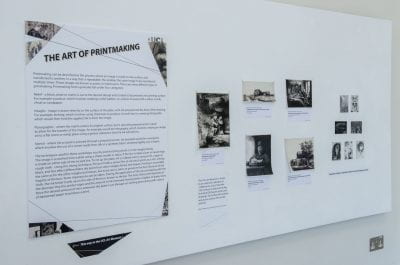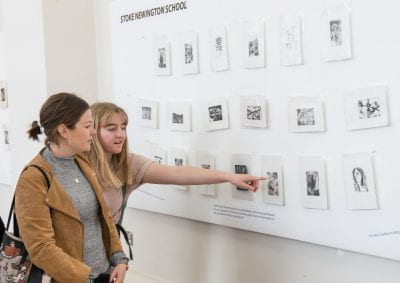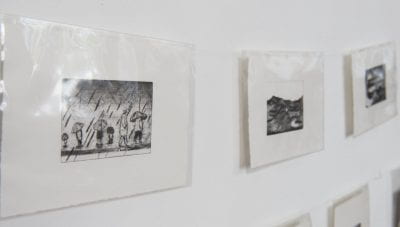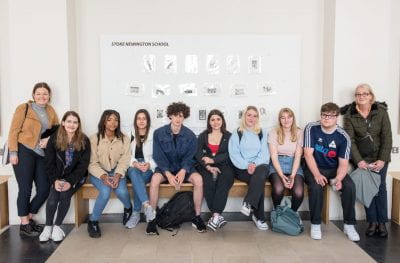Make an Impression: From Conception to Realisation
By e.edem-jordjie, on 21 May 2019
This blog has been written by Edinam Edem-Jordjie, a STEP Intern with the UCL East Community Engagement Team.
(STEP) ping into place
In the North Cloisters, from the 12th April until the 24th May, UCL Culture presents ‘Make an Impression: Prints from East London schools’. A new exhibition featuring 90 small scale black and white dry point etchings by young people from six colleges and schools across East London, with support from UCL staff and Slade School of Fine Art students. This exhibition was co curated by Emma Bryant, the Schools Engagement Manager and I, Edinam Edem-Jordjie, the STEP Intern for UCL Culture and UCL East. We co curated this exhibition with the intent to showcase the student’s prints and to highlight the work that UCL Culture is doing in east London, as we move towards the opening of our UCL East Campus. How the opportunity for me to curate this exhibition came to be for a multitude of reasons but none more important than the reason I’m here in the first place. STEP and UCL Culture.
The Shared Employment and Training Programme (STEP) is a 12-month London Living Wage paid Internship programme for the creative and cultural sector. Established by the London Legacy Development Corporation (LLDC), this programme gives young people the opportunity to work across two different organisations or two different departments within the same organisation. Interns work across 7 organisations (Worldwide FM, London College of Fashion, Bow Arts, Sadler’s Wells, The Film Office, Artichoke, V&A, and UCL) who are of the East Bank development on Queen Elizabeth Olympic Park. I am currently completing a 12 month internship at UCL, with 6 months in the Exhibition department for the Museum & Cultural Programmes Team and the rest of the internship in the UCL Community Engagement Team (East).
It’s because of STEP that I’m I started in UCL Culture in the first place and what led to the circumstances that enabled me to co – curate this exhibition and gave me the skills and knowledge needed to curate one. This exhibition marks the end of my time in exhibitions and I think it’s fitting that my last project got to incorporate a little bit of everything that I’ve experienced and learned throughout my internship, from learning how to use software such as InDesign and Illustrator to being involved in projects that have taken me to the UCL Art Museum, The Grant Museum and across East London.
To mark this occasion, I thought I would document my experience of co-curating this exhibition, from conception to realisation. So without further ado, this is my experience of curating ‘Make an Impression: Prints from East London Schools’.
How it began
On the 27th day of November, last year, I was invited to help facilitate a printmaking workshop with students from Sir George Monoux College. The workshop introduces students to the art of dry point etching and gives them practical printmaking skills, alongside an insight into what it’s like to study Fine Art at a world class university. The workshop is run by UCL Culture in partnership with the UCL Art Museum and the Slade school of Art. For those of you who don’t know what UCL Culture is, UCL Culture is the creative force behind the university’s museums, collections and theatres and who facilitate engagement and curate UCL content.
The printmaking workshop is one of many run by the department’s Schools Engagement Team, which are designed to activate the museum’s collections and run with the intent to engage young people with the university. The workshop was run over 2 days with one day spent on campus at the UCL Art Museum and the Slade School of Art; with the other day spent at the school/college of the participating students.
On the first day at UCL Art Museum, students look at original prints by celebrated artists such as Rembrandt van Rijn and James Abbott McNeill Whistler to learn about technique, symbolism and composition. The students have the UCL Art Museum to themselves, with the original prints mounted into frames and put on display across the museum. In addition to studying the prints, students also get the opportunity to try and draw the original prints, so that they can try and emulate the technique and composition as well as learning the difference between using a stylus to scratch an image on to plate versus using a pencil to draw an image on to a piece of paper. Each class is then given a guided tour of UCL by students from the university, where they can see inside the artist studios and the work being produced by students here today, as well as learning about what it’s like to study Art at UCL. At the end of the day in the printmaking studio, students make a joint etching and see the whole printmaking process from conception to realisation.
On the second day at their school or college, students work with two artists who have studied at the Slade to produce a piece of work suitable for their artist portfolios. UCL provides all the technical equipment needed in a mini-printmaking studio, which fits into a large suitcase. Students are taught how to use the printing plates and tools in the dry point technique, before having a go with the etching press themselves and inking up a plate to create their prints. These prints go through several metamorphoses before reaching the final versions of the images.
The opportunity to take part this workshop was really exciting to me, as my only experience with printmaking t was dipping shaped sponges into paint in primary school. So it was interesting to learn about and see all the different forms of printmaking and to try what was practically a new art form to me. I also got the chance to see more of the campus and the Slade School of Art, which t I hadn’t got to know yet as I was only 2 weeks into my internship at the time. After the workshop, I commented on how interesting and informative I found the workshop and that it would be nice if the prints that the students created could go on display. Emma had been planning to show the prints, but hadn’t firmed up how yet. When she asked me to co-curate an exhibition I felt a bit unsure as I didn’t think that I could do it. However Emma was adamant that we should at least try and before I knew it the exhibition was born. I’d never really considered just how much work actually went into co curating an exhibition. We roughly knew what we wanted the exhibition to be about but everything else was still up in the air. I was given the tasks of designing the layout and the interpretation panels. It was a big task, from collecting the materials to deciding what message/statement I wanted to get across with the exhibition. So before anything else, the first thing that I did was research. If I was going to create an exhibition about printmaking, I wanted to be sure that I knew what I was talking about so that the art of printmaking could be accurately represented in the layout and in the interpretation panels.
An Introduction to Printmaking

Image of board that explains the process of printmaking for Make an Impression exhibition in the North Cloisters.
Today, looking at the various ways in which one can see the same image – through social media, posters, billboards, adverts etc., it can be difficult to imagine a world where images are rare. Yet, prior to the invention of printmaking, that was the way the world was. Images were by and large found locked away in places which few, typically the very wealthy, had access to, such as palaces.
Printmaking can be described as the process where an image is made on one surface, and transferred to another, in a way that is repeatable; this enables the same image to be reproduced multiple times. These images are known as prints or impressions.
The idea of making repeatable designs can be traced back to Mesopotamia, one of the earliest known civilisations who created designs on to the end of cylinder seal, which when rolled on to clay tablets left impressions. This was typically used for stamps and signatures. Prior to the invention of the woodblock printing technique which forms the basis of printmaking as a technique as we know it today, this was the only way to duplicate designs.
The woodblock printing technique originated in China as a method of printing on textiles and later paper. Printing with this technique involves creating a relief pattern on a block of wood with a either a knife, chisel or sandpaper. A relief pattern means that the areas which are meant to be ink-free are that bits that are cut away. Once left with the desired design on the block of wood, you then ink it and press it on to either a paper or cloth, to leave a print.
The technology of printmaking forever changed our perception of images. It made it possible for hundreds of practically identical images to be produced from one template within hours whereas before, it could have very well taken a lifetime for the same result to be achieved by hand. When this invention was followed by the printing press which allowed books, newspapers etc. to be produced in the same manner and speed,the possibilities for the spread and knowledge and ideas were limitless. Printmaking was initially used to reproduce different religious texts and manuscripts for distribution. However as it spread through Asia and then on to the rest of the world, the demands and needs for printing changed. In Europe, for example, the initial demand driving the early print market were playing cards and cheap devotional images.
Printmaking was an important vehicle for social change as it facilitated the wide circulation of symbols, ideas and information. What was once accessible to a few, typically the very wealthy and educated, suddenly became accessible to all as printmaking provided a means of mass-producing objects that brought them within the reach of even the poorest members of society. It led to; the democratisation of knowledge, the decline of Pan-European Latin in Europe, the first copyright laws and the invention of the news media, commonly called the press, after the printing press.
Printing in general was about ensuring that works, whether they were religious, manuscripts, art or the news, were readily made available and accessible to large groups of people. It has shaped the way we live and think today. It is through printmaking that we have most of our earlier art forms reproduced and preserved for today’s generation and printing in general that we have knowledge of past events.
Seeing as how there are many different types of printmaking, I enquired as to why the art of dry point etching was chosen for the workshop. There are benefits and drawbacks for each printmaking method and dry point was chosen for its benefit of often being regarded as the simplest intaglio (where the image is created directly on the plate) method because the sharp stylus or needle which is used to scratch lines directly into the metal plate, works in a similar way in which one would use a pencil/pen to paper which makes it easier for students to get used to considering the time restraints. It is also the safest in terms of the materials used, as it doesn’t require acid like some methods do. It is also something that isn’t taught in schools a lot, so using this method is a great way to introduce people to the art of printmaking relatively quickly. In all, you could say that drypoint is a simple yet effective way to introduce someone to the art of printmaking.
Making an Impression
After I finished my research about printmaking, I had to find a way to condense all the information I’d learnt along with information about the printmaking workshop and the exhibition onto three panels with no more than 450 words on them. I had to find a way to make sure that the panels came across as informative but clear without being patronising. What I’ve written about the workshop and printmaking process here is essentially the long form version of what is written on the panels. The whole process of designing panels was new to me as prior to starting this internship, I had never I used design software such as Adobe Illustrator and InDesign. Throughout March when I was designing the panels, I went to several exhibitions at organisations such as; the V&A, The British Library, The Museum of London and the National Gallery, and past exhibitions by run by UCL Culture. I did this because I wanted to see the different ways in which organisations interpreted works of art and to note how the styles and messages changed depending on who the audience was.
When starting the process, I just knew that I wanted panels that were simple, informative and which had elements of printmaking as an art form represented on them. What I really like about drypoint, is that simplicity allows you to see the beauty of the details, like the burr (a raised edge) and the different shading/texture, so I wanted the design of the interpretation panels to reflect that. All I used to design the panels were the colours; black, white & beige, lines and images of scanned Rembrandt prints from the UCL Art Museum, along with a few images of the workshop. Seeing as how I’m still relatively new to using design software, I thought it’d be best if I made the best use out of what I already knew.
The same thought process was used in designing the layout of the prints. We decided to hang the prints on a string, in a similar fashion to the way the prints are hung to dry after being run through a printing press. Considering that we have 90 prints on display, we wanted to display it in a way that ensured that the prints were the focus of attention and that they weren’t cluttered.
The last thing to do after the design process was to host a launch event. We wanted to host the event to not only promote the exhibition but to give all the participating students a chance to come in and view their work. We opened the event to the participating students and their families, teachers, governors, head teachers and partners that UCL Culture has across the university and beyond. We hosted the launch on the 30th of April and had over 40 guests in attendance. Alongside viewing the exhibition, we also had refreshments, a speech by Kieran Reed – director of the Slade School of Art, a tour of the UCL Art Museum and a private viewing of the Rembrandt prints. It was a really nice night and a good way to end the exhibition project.
Lasting Impressions
The event also marked my last day in the exhibitions department. Seeing as how my second internship involves me working in UCL East, the exhibition project was a nice way to say goodbye to the exhibitions department as I got to use all the skills I had acquired throughout my internship, and a nice way to say hello to the UCL East community engagement department as I got to experience some of the work that UCL is doing in east London, as they move towards the opening of the UCL East campus. I am really glad that I got to do this exhibition project, especially as it wasn’t in my original work plan. I was offered the chance to experience a printmaking workshop and got the incredible opportunity of curating my own exhibition as a result from it.
Doing this project opened my eyes to a lot of things, from seeing whether I was capable of using the skills I had learned throughout my time in exhibitions to the logistics that go in to planning events. I feel like it prepared me for a lot of the event work that I’m going to be doing in my second internship.
Coming into STEP, I wasn’t sure what to expect and I was worried that a lot of the work I was going to be doing was purely admin. Not that admin is bad, but being on an internship should be an experience to learn to do all types of things and I’m glad that STEP and UCL Culture has given me the opportunity to do that so far. If you told me six months ago that I would be curating my own exhibition, I’d never have believed you. But I’ve done it and now I’m here. If this is what I’ve managed to do in the first half of my internship, I’m really excited for what comes next!
With thanks to the students and staff at: Stoke Newington School, BSix Sixth Form College, NewVic Sixth Form College, Hackney New School, Sir George Monoux College and Canary Wharf College. Special thanks to the: The UCL Art Museum and the Slade School of Fine Art and its students. Exhibition and workshops made possible by UCL Culture and Access and Widening Participation.
 Close
Close








